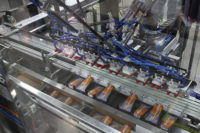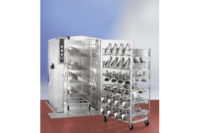Bakers and snack producers know that keeping their products at the right temperature from production through distribution is key to food safety and freshness. Innovations in cold storage and refrigeration equipment are offering these food manufacturers new ways to keep their goods cool, even when demand for them heats up.
Cold storage and refrigeration are key variables in moving food products through the supply chain, from production through distribution. Maintaining precise temperature control throughout the journey is the goal. New refrigeration technology and third-party providers are offering bakeries and snack manufacturers more options when it comes to keeping their products at just the right temperature.
Linde North America, Murray Hill, N.J., manufactures in-line chilling and freezing systems that use cryogenic technology. “Our cryogenic freezing systems allow customers to increase throughput in a small footprint, while producing value-added frozen or chilled bakery and snack products,” says Ed Cordiano, program manager, bakery and prepared foods. “Our cryogenic chilling solutions include traditional spirals and tunnels as well as a proprietary dry-ingredient chilling system.”
The dry-ingredient chilling system allows bakery and snack food plants to control the temperature of ingredients before mixing. By ensuring consistent ingredient temperatures, food processors are able to improve yield and efficiency while producing a high-quality product. “At several cookie dough manufacturers, this chilling system ensures that each batch of dough is consistent and repeatable,” Cordiano explains. “Once the ingredients are fully mixed and the dough is made, our cryogenic spirals freeze the product prior to packaging.”
Praxair Inc., Danbury, Conn., manufactures in-line cryogenic freezing and chilling systems that allow bakery and snack food processors to quickly chill their products to retain appearance, quality and shape for packaging. “We offer bakery customers three types of tunnel freezers,” says Frank J. Martin, marketing manager, food refrigeration. “We build these tunnels in a modular design and install them in lengths from 9 ft. to 81 ft., based on product freezing rates, heat removal and desired production rates.” Praxair’s cryogenic spiral freezers come in three sizes that can be shipped over-the-road pre-fabricated or built in-place at a customer’s facility.
In-line chilling of finished bakery products is an important application, according to Martin. A small cryogenic system can quickly set up coatings or frosting on finished goods to preserve the appearance right through the packaging process. “Often the same cryogenic supply system used for freezing can be used to control dough temperatures in the mixers,” he explains. “This can lead to optimum product temperature after the preparation process and further improves product quality.”
Colmac Coil, Colville, Wash., manufactures industrial refrigeration equipment that uses natural refrigerants, ammonia and carbon dioxide (CO2). “Compared to synthetic [hydrofluorocarbon] refrigerants, these natural refrigerants are environmentally benign, lower in cost and energy efficient,” says Jeremy Olberding, sales manager. “We also manufacture refrigeration evaporators (cooling units) with a proprietary antimicrobial fin material. This material is corrosion-resistant, has strong heat-transfer characteristics and actively kills pathogens.” The company plans to focus future product development on refrigeration evaporator designs that reduce refrigerant charge, improve energy efficiency and facilitate cleaning.
Doug Thomas, chairman of the International Association of Refrigerated Warehouses (IARW), Alexandria, Va., says a new system developed by Los Angeles Cold Storage, Los Angeles, is an exciting new development in refrigeration engineering. Called NXTCOLD, the system uses significantly less ammonia refrigerant, is less expensive to operate and achieves the same objective for various applications.
A self-contained ammonia refrigeration system, NXTCOLD is fully automated and eliminates the need for an engine room. The system controls the evaporator liquid feed rate based on ammonia vapor quality within the evaporator. It uses a very low ammonia charge (VLC) that has 98% less ammonia than many systems currently in operation, Thomas says.
Specialized conveyors are used to move refrigerated goods through the production process. Ashworth Bros. Inc., Fall River, Mass., manufactures the Advantage hybrid plastic spiral freezer belt for bakery and snack food plants. The belt provides airflow and release characteristics that minimize product damage and reduce energy costs, according to Kenneth King, commercial support manager.
“The traditional all-plastic belt design utilizes modules with increased mass in order to support a product load within a spiral freezing system,” King explains. “The increased mass of the module reduces open area, thus limiting airflow, which results in longer product dwell times. The Advantage belt has modules with less bulk, allowing for more open area.”
Third-party providers
Cold storage companies can help bakeries and snack manufacturer distribute their perishables by working with them as third-party providers. “Cold storage operators can assist the bakery/snack industry with leading-edge technology related to product tracking, temperature and sanitation integrity safeguards while providing economies of scale that would otherwise not be possible in a standalone, privately dedicated warehouse/logistics operation,” Thomas explains.
Henningsen Cold Storage Co., Hillsboro, Ore., is one such company. Henningsen provides multi-temperature space for bakers and snack producers. “We handle and store multiple types of food products every day of the year,” says Tony Lucarelli, executive vice president, sales and marketing. “Thus, clients only pay for the space and services they require versus having to carry the overhead on their own. In addition, our transportation services division can provide both inbound and outbound solutions for clients, all with a single point of contact.”
Lucarelli says recent advances in cold storage include LED lighting, variable-frequency drives on all compressors and evaporators and more automation in warehouse facilities and material handling equipment. He also sees a possible movement from wood pallets to composite material pallets, which will improve durability, safety and longevity.
A M King Construction, Charlotte, N.C., designs and builds cold storage facilities, including spaces with temperatures ranging from blast freezing operations of -40 deg. F to refrigerated spaces for fruits and vegetables maintained at 55 deg. F. “In the past few years, many snack and bakery producers have recognized the benefits of refrigerated spaces and have begun to use a greater amount of cold storage in their operations” notes Brian King, president. “This has been particularly relevant in the use of freezer facilities to initially blast freeze their product after production, and then to maintain product in freezers, so they may increase product life and maximize the freshness when distributed to the consumer. We have seen this growth in the bakery industry for baked goods ranging from bread to buns to rolls.”
King says food processors are also seeking smarter, fully automated buildings that analyze, respond and control their environments—buildings that can be tailored to specific needs based upon the products they are producing or storing. “Not only do we see food operations seeking more automation in their processes and production, but in their facilities as well,” he notes.
Mobile warehouses
Today’s bakers and snack producers are not only looking for more efficient refrigeration systems and off-site cold storage, they also want more storage flexibility.
Demountable Concepts Inc., Glassboro, N.J., has developed a “warehouse on wheels” system that allows food distributors to access remote markets without the need for a regional warehouse or cross-dock facility. Multiple, self-contained, refrigerated van bodies are shuttled from a centralized distribution center to an outlying market, where local drivers make immediate deliveries.
“Demountable truck-body systems are an extension of a customer’s warehouse,” says Mark Ansberry, director of sales. “Refrigerated van bodies can be loaded at the dock while a truck is out on a delivery run. This keeps the warehouse staging area clean and allows for a quick turn time for the driver. A five-minute swap is all that’s required, and the driver is ready for a second trip.”
Ansberry sees broader use of this concept in the U.S. with distributors whose deliveries require a straight truck. “We are working with van body and reefer manufacturers to offer multi-temperature and frozen van bodies,” he explains. “A cultural shift from regional warehousing to centralized hub and spoke deliveries will help foster this growth.”
Under control
Besides in-plant refrigeration systems and off-site cold storage facilities, a variety of other equipment is available to help bakers and snack producers keep their products at the right temperature.
TempTRIP, LLC, Broomfield, Colo., has introduced a temperature tag designed to simplify cold storage management throughout the supply chain. The ultra high frequency (UHF) tag features a button that the user presses to start and/or mark temperature data at multiple points throughout the product’s journey. When the button is pressed, an LED light blinks red if the temperature is out of range or displays a solid green if programmed parameters are being met. The tag can be affixed to packages, cases or pallets and is capable of logging thousands of time/temperature points.
“Companies can program the tags with time and temperature variables specific to any food product so they have a good handle on remaining shelf life,” says CEO Phaedra Culjak. “This can be done at any point in the product lifecycle.”
Maintaining proper temperature is crucial at the end of the supply chain as well, when food is stored in refrigerated retail display cases. It can be challenging providing maximum visibility for the consumer, while keeping products at the proper temperature.
Bakery merchandisers from Master-Bilt Products, New Albany, Miss., are designed with minimal glass framing, so that maximum visibility is on the product inside. “The front glass frame tilts outward to make cleaning and loading easier,” says Lynn Burge, marketing manager. “The merchandisers are classified to NSF standards for food-zone requirements. This allows the storing of food in open containers, pans and platters. It also reduces packaging costs and offers more convenience to customers.”
Frozen display merchandisers from Excellence Industries, Tampa, Fla., also are designed to market food products. “By utilizing graphics, glass doors and illumination, our equipment is designed to drive traffic to refrigerated and frozen products and increase sales,” says Dell Dahl, president. “The merchandisers also incorporate green technology to reduce energy costs for our clients.” In an effort to implement stronger sustainability practices, the company has transitioned to new hydrocarbon refrigerants such as R290 propane. Most of its models are already available with propane refrigerant, with more to come in 2014.
Whether they’re looking for an onsite chilling or freezer system or an offsite cold storage facility, today’s bakers and snack producers have a variety of options from which to choose to keep their products cold…and demand for their goods hot.













